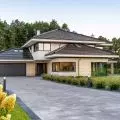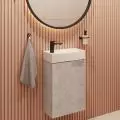Ola: The {tag:pracownie} office was established 13 years ago, how has the perception and popularity of passive houses changed in that time?
Agnieszka: It's quite interesting. The popularity of these buildings is certainly growing, although it is happening rather organically. For the last 4.5 years we have closed ourselves off a bit in the studio, because we had a lot of clients and didn't notice at all what was going on around us. Or rather, that nothing was happening! In 2015,2016 we completed the last environmental education projects, at the beginning of the business we also published two guides on passive construction, organized series of trainings, workshops, recorded videos on Youtube.
Bartosz: We also recorded videos broadcast on TV, and organized large, nationwide conferences.
Agnieszka: The conferences were the largest of their kind in Poland - we organized passive construction forums during BUDMA together with the Polish Passive Building Institute. This was during the time of Mr. Gunter Szlagowski's activity, who was striving to make the passive standard common in Poland. We were part of these activities, later also co-organizing events as the Polish Passive House Association. A huge void was left after Mr. Szlagowski's death.
Bartosz: There was a lack of a leader.
Agnieszka: And all activities promoting passive construction froze. Therefore, this year we decided to return to these activities and share as widely as possible the know-how developed over the years and the knowledge gained. This year we organized a conference at BUDMA, which, for a return after several years, was a great success.
We also organized a four-week free course for female architects who would like to design zero-emission buildings. 1,200 architects signed up for the course, and nearly 800 of them attended! At the course we showed our realizations, the technologies and solutions we used, details and details. We also presented a financial analysis of the zero-emission house we are building using various alternatives. It turned out that the demand for this kind of knowledge is huge! The training came out fantastic, we got a lot of positive feedback, feedback about how this course is important, needed, because no one in this environment shared reliable knowledge backed by experience.
Bartosz: Nearly 800 architects attended our training every week, reviewed the materials we sent them, did the exercises, approaching the learning very diligently, even though everyone was busy after all. So you can see that there is a great need in the architectural community to gain this knowledge, to learn how to design such buildings. We hope that this will be a new wave that will cause a change in thinking among architects, and later investors and the rest of the industry.
Ola: What are your future plans?
Agnieszka: Architects who have taken the four-week course will be able to join an advanced six-month training program, where participants, under our supervision, will design their first zero-emission building. So for the next six months we will be working on this program. But we will definitely be returning to four-week courses and shorter online conferences. We also plan to do a course on zero-emission building for individual investors.
Bartosz: We already have a queue of architects waiting for the next edition of the course. We will definitely continue our activities, not only because we see a change in architects, but also because it gives us tremendous pleasure.
Agnieszka: I didn't expect such an effect. Architects write that we have created a super platform full of kindness, good mood, where you can exchange your thoughts. We approach it the same way - architects are super, it's great to work with them, it's fun to show them our solutions, to be able to share knowledge. To show that zero-emission construction is one hundred percent accessible and does not limit in any way in the creation of solids and aesthetics.
Contrasting house, Pruszkow
© Passive M2
Bartosz: We ourselves work and live in a house that is passive standard. Our apartment is located in a historic building. A few years ago, we had our attic thermo-modernized according to the passive standard. When it comes to thermal retrofitting, the standard is called EnerPHit. As far as we know, this is the only such project in Poland! We have transformed a neglected attic of a historic tenement house into a full-fledged residential and office building, which, thanks to the placement of a photovoltaic installation on the roof, generates no bills for the energy consumed! If we are able to convert an old attic into a zero-energy facility and at a cost lower than buying an apartment, it can be done with any building. Yes, such a project is more difficult, you have to work harder, but it's worth it! We live and work in the center of Poznań, on one of the main streets, but it is very quiet in our apartment and office, because this standard also makes the apartment soundproofed, and our employees - architects, have ideal conditions for work. We breathe fresh, filtered air. Anyone who doubts whether they should have a house with mechanical ventilation should see the video where I change the filter during the heating season - he is completely black! This means that without it, all these pollutants would end up in our lungs, and those who don't have mechanical ventilation with filters are breathing exactly that... And this is, on the one hand, scary, and on the other hand, motivating to further develop zero-emission housing.
Ola: This reminded me that I should check the filter in my air purifier. Thank you very much for the interview!




























